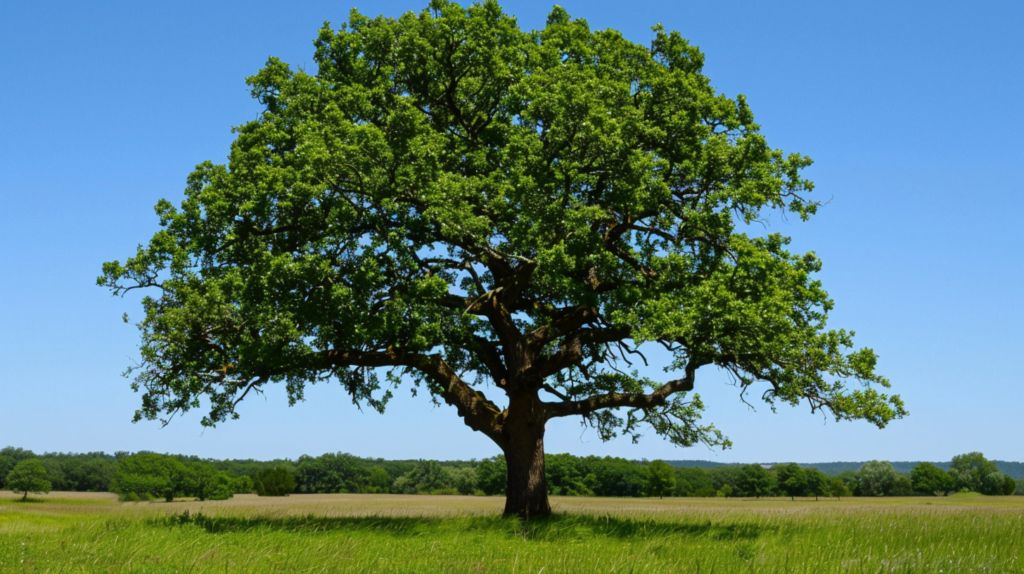Table of Contents
Oak trees are a common sight in many parts of the world, providing shade, beauty, and oxygen to our environment. However, for some individuals, oak trees can be more than just a pleasant addition to the landscape – they can be a source of allergies. While oak trees are not typically associated with allergies, they can indeed cause allergic reactions in some people. In this article, we will delve into the world of oak tree allergies, exploring what they are, the different types, causes, symptoms, diagnosis, treatment, and prevention strategies.
What Are Oak Tree Allergies?
Oak tree allergies are an immune system reaction to one or more substances produced by oak trees, such as pollen, sap, or leaves. When an individual with an oak tree allergy comes into contact with these substances, their immune system mistakenly identifies them as harmful and launches an attack, leading to a range of symptoms. Oak tree allergies can manifest in different ways, including hay fever, contact dermatitis, and respiratory issues like asthma.
Understanding Oak Tree Allergies: What You Need to Know
Oak tree allergies are often overlooked, but they can have a significant impact on daily life. For those affected, understanding the basics of oak tree allergies is crucial for managing symptoms and preventing reactions.
Types of Oak Tree Allergies
Oak tree allergies can take several forms, each with its unique set of symptoms and triggers.
Pollen Allergy (Hay Fever or Allergic Rhinitis)
Pollen allergy, also known as hay fever or allergic rhinitis, is the most common type of oak tree allergy. It occurs when the immune system reacts to oak tree pollen, leading to a range of symptoms including:
- Nasal congestion and sinus pressure
- Itchy, watery eyes
- Sneezing and coughing
- Runny nose
- Postnasal drip
Oak tree pollen is released into the air during the spring and fall, when the trees are in bloom. This pollen can travel long distances, affecting people even if they are not directly near an oak tree.
Contact Dermatitis (Skin Allergy)
Contact dermatitis is a skin reaction that occurs when an individual comes into contact with oak tree sap, leaves, or bark. This type of allergy can cause:
- Redness and inflammation
- Itching and burning
- Blisters and rashes
- Dry, cracked skin
Contact dermatitis can be caused by direct contact with oak tree parts or by touching something that has come into contact with the tree.
Respiratory Issues (Asthma)
For individuals with asthma, oak tree allergens can exacerbate symptoms, leading to:
- Wheezing and coughing
- Shortness of breath
- Chest tightness
- Quick shallow breathing
Oak tree allergens can trigger asthma attacks, making it essential for those with asthma to take precautions when around oak trees.
Causes and Triggers of Oak Tree Allergies
So, what causes oak tree allergies, and how can you identify triggers?
Oak Tree Pollen: The Primary Allergen
Oak tree pollen is the primary allergen responsible for oak tree allergies. Pollen is produced by male oak trees and is released into the air during the spring and fall. Peak pollen seasons vary by region, but generally occur from March to May and September to November.
| Region | Peak Pollen Season |
|---|---|
| Northern Hemisphere | March to May, September to November |
| Southern Hemisphere | September to November, March to May |
Other Potential Allergens in Oak Trees
While pollen is the primary allergen, other parts of the oak tree can also cause allergic reactions. Oak tree sap, leaves, and bark contain substances that can trigger contact dermatitis and respiratory issues.
Symptoms of Oak Tree Allergies
Recognizing the symptoms of oak tree allergies is crucial for proper diagnosis and treatment.
Common Symptoms of Oak Tree Allergies
Oak tree allergies can cause a range of symptoms, including:
- Nasal congestion and sinus pressure
- Itchy, watery eyes
- Sneezing and coughing
- Runny nose
- Postnasal drip
- Skin rashes or hives
- Itching and burning
- Blisters and rashes
- Dry, cracked skin
- Wheezing and coughing
- Shortness of breath
- Chest tightness
- Quick shallow breathing
Severe Symptoms and When to Seek Medical Attention
In rare cases, oak tree allergies can cause severe symptoms, including:
- Anaphylaxis (a life-threatening allergic reaction)
- Swelling of the face, lips, tongue, or throat
- Difficulty breathing
- Dizziness or fainting
If you experience any of these severe symptoms, seek medical attention immediately.

Diagnosis and Treatment of Oak Tree Allergies
Diagnosing oak tree allergies typically involves a combination of medical history, physical examination, and diagnostic tests.
Diagnostic Tests for Oak Tree Allergies
Diagnostic tests for oak tree allergies include:
- Skin Prick Test: A small amount of oak tree pollen or extract is placed on the skin, and the reaction is observed.
- Blood Tests: Blood tests, such as RAST or ELISA, measure the level of allergy-related antibodies in the blood.
Treatment Options for Oak Tree Allergies
Treatment for oak tree allergies depends on the severity of symptoms and the type of allergy. Common treatment options include:
- Over-the-Counter Medications: Antihistamines, decongestants, and corticosteroids can help alleviate symptoms.
- Prescription Medications: Immunotherapy, also known as allergy shots, can provide long-term relief.
- Home Remedies and Natural Treatments: Nasal filters, air purifiers, and herbal remedies like butterbur and quercetin may also be effective.
Prevention and Management of Oak Tree Allergies
Preventing and managing oak tree allergies requires a combination of avoidance, reduction, and treatment strategies.
Avoiding Oak Tree Allergens
To avoid oak tree allergens, try:
- Staying indoors during peak pollen seasons
- Wearing protective gear when outdoors, such as masks and goggles
- Avoiding activities that stir up pollen, like mowing or raking leaves
Reducing Exposure to Oak Tree Allergens
To reduce exposure to oak tree allergens, try:
- Using air purifiers and HEPA filters to remove pollen from the air
- Keeping windows and doors closed during peak pollen seasons
- Using a dehumidifier to reduce moisture, which can help prevent mold growth
Managing Symptoms and Preventing Reactions
To manage symptoms and prevent reactions, try:
- Carrying emergency medication, such as an EpiPen
- Informing others about your allergy, such as friends, family, and healthcare providers
- Wearing a medical alert bracelet or carrying an allergy card
Conclusion
Oak tree allergies may not be as well-known as other allergies, but they can have a significant impact on daily life. By understanding the types, causes, symptoms, diagnosis, treatment, and prevention strategies, individuals can take control of their oak tree allergies and enjoy the beauty of these magnificent trees without fear of reaction. Remember, if you suspect you have an oak tree allergy, consult a healthcare professional for proper diagnosis and treatment.
Final Thoughts
Oak tree allergies are a reminder that even the most seemingly harmless substances can cause harm. By being aware of the potential for oak tree allergies, we can take steps to protect ourselves and others. So, the next time you’re enjoying the shade of an oak tree, remember to take a deep breath – but not too deep, if you’re allergic




